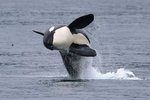The annual Bigg’s killer whale sightings record has been surpassed after nearly 30 Bigg’s whales were seen over Labor Day weekend in the Salish Sea.
As of Sept. 6, unique sightings of …
This item is available in full to subscribers.
We have recently launched a new and improved website. To continue reading, you will need to either log into your subscriber account, or purchase a new subscription.
If you had an active account on our previous website, then you have an account here. Simply reset your password to regain access to your account.
If you did not have an account on our previous website, but are a current print subscriber, click here to set up your website account.
Otherwise, click here to view your options for subscribing.
* Having trouble? Call our circulation department at 360-385-2900, or email our support.
Please log in to continue |
|


The annual Bigg’s killer whale sightings record has been surpassed after nearly 30 Bigg’s whales were seen over Labor Day weekend in the Salish Sea.
As of Sept. 6, unique sightings of Bigg’s killer whales have reached 793 in 2021, breaking the previous record of 747 sightings in 2019, according to the Pacific Whale Watch Association.
“We have been seeing a lot of Bigg’s the past few years,” said Erin Gless, executive director for the association. “What’s happening for the Bigg’s is very encouraging.”
The increase in Bigg’s killer whale sightings coincides with research from the Orca Behavior Institute, which has documented more than 70 different Bigg’s whales last month.
With four months remaining in 2021, many are optimistic the record will continue to grow for Bigg’s whale sightings.
A unique sighting is a report of a unique group of whales on a given day. A sea captain based out of Sooke, British Columbia observed seven different Bigg’s whale families on Saturday, Sept. 4.
“I’ve never seen so many Bigg’s at once,” Captain Paul Pudwell said. “It was a special day.”
Although Bigg’s killer whales, also referred to as transient whales, have increasingly been observed, Puget Sound’s southern resident killer whales have continued to decline in population over the past 15 years. Southern resident whales exclusively eat salmon, a food source that has declined in population over the years for the whales.
An abundance of food has led to the birth of 130 Bigg’s whale calves over the last decade, however, and they have maintained a population growth rate of over 4 percent per year.
While the two groups of whales look very similar, they are vastly different in diet, culture, and habitat.
Bigg’s whales eat a variety of mammals such as harbor seals and porpoises, while southern resident whales only eat salmon.
The difference in diet has led to contrasting population sizes and trajectories for each killer whale group, but Gless remains optimistic for southern resident whales, based on the optimal increase in Bigg’s whale sightings.
“The contrast in health between these two orca populations is striking,” Gless said. “Bigg’s prove that killer whales can thrive in this region, so long as there is food. If we can restore local salmon populations, we have hope that southern residents can recover. The priority has to be getting them more food.”
The solution for southern resident whales isn’t as simple as switching to a new food source other than salmon though, as they have relied on the food source for over a half-million years.
“If a lion is starving in Africa, they don’t look to the grass as food,” Gless said.
Chinook salmon, the preferred food source for southern resident whales, have sharply declined in population due to habitat loss and degradation, commercial fishing harvest rates, climate change, and dams that impede salmon migration according to the U.S. Environmental Protection Agency.
As of 2018, Salish Sea Chinook salmon populations have declined by 60 percent since the EPA began tracking salmon abundance in 1984.
There is some optimism for southern resident orcas, though, as the Orca Network, a nonprofit based on Whidbey Island, observed southern resident whales making an early return to Puget Sound.
The southern resident orcas were seen near the San Juan Islands feeding on salmon on Sept. 7.
With reduced salmon abundance in Puget Sound, southern resident whales typically seek food outside of the area until October, but the southern resident J-Pod entered Puget Sound, and were observed passing close to Bush Point, which is on Whidbey Island due east of Marrowstone Island.
“[Southern resident whales] are coming here for the Chinook salmon that are returning to the Salish Coast ecosystem,” said Ken Balcomb, founder and director of the Center for Whale Research.
“Cherish their arrival as representing that there is some remaining health to these amazing waters,” he added.
Although the visit was short-lived, and the southern resident orcas returned to the San Juan Islands the following day, it served as an encouraging observation that the southern resident orcas were willing to travel inland for food this early in the year, the Orca Network said.
“There’s been so much talk about the southern resident’s struggle, pollution [and] underwater sound, the truth is we’re talking about the same environment,” Gless said. “If we can get more salmon, the southern residents can grow.”